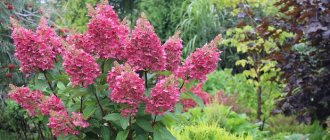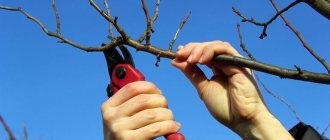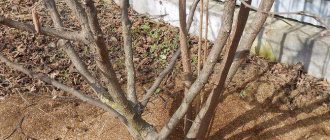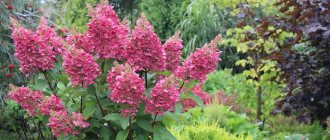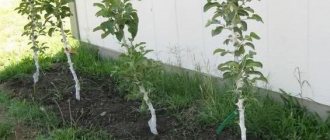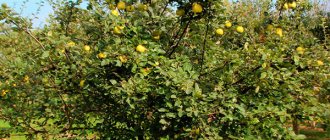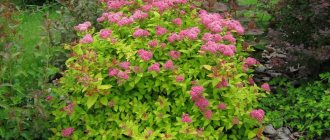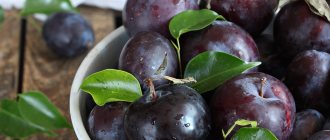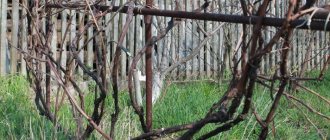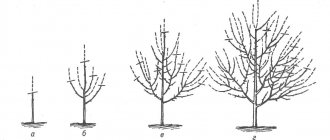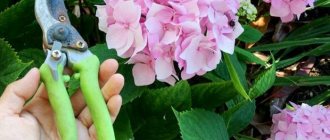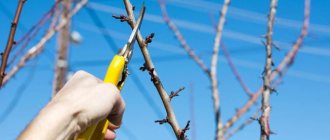Hydrangea is an ornamental shrub from the family of the same name. More than 50 types of culture are known, originating from Southeast Asia, North and South America, and the Far East. Plants were brought to Europe in the 17th and 18th centuries. Now more than 100 highly decorative varieties have been bred. The botanical name is Hydrangea (moisture-loving), the Japanese is “Ajisai” (translated as “flower like a purple sun”). For beginning amateur gardeners, it is not always clear how tall plants can reach and whether they need pruning. Pruning rules depend on the variety, age of the plant and growing region.
Biological types of Hydrangea, features of their branching and flowering
To understand how to prune, whether to do it in autumn or spring, you need to know the branching pattern and flowering characteristics of the biological species. It is important how winter-hardy the cultivated species is. When purchasing a shrub, you should find out its biological (Latin) name. The three most common varieties are:
- tree-like;
- broadleaf (garden, large-leaved);
- paniculata.
Tree hydrangea (Hydrangea arborescens).
This species is native to the west coast of North America, where summers are long and winters are not too cold. Therefore, in the regions of Siberia, it can go into winter with shoots not covered with bark. Such branches will inevitably die. The buds are arranged in pairs and the branching of shoots also occurs in pairs. Currently, the plant has become widespread in the world due to the fact that winters in some regions have become warmer. The form is unpretentious and is not affected by diseases and pests. In landscape design it is used as a single plant (solitary plant), to create curtains and hedges.
The main pruning of tree-like Hydrangea is carried out in the fall. The feasibility of this operation is as follows:
- prevention of branches breaking off due to the fact that the left inflorescences collect caps of snow in winter;
- saving time in the spring, when a lot of work is required with the soil, sowing and planting other crops;
- use of cut biological mass to cover garden strawberries, grapes and other crops.
Garden hydrangea (Hydrangea macrophylla)
This variety is called southern, large-leaved, broad-leaved or colored. It comes from Southeast Asia and does not tolerate frosts below -15°C. The flowers are collected in inflorescences-corymbs, which are formed at the ends of last year's shoots. The only species that responds to soil acidity by coloring its flowers. Thus, in an alkaline environment, the flowers of the plant have a pink or delicate purple tint. In an acidic environment it is blue or cyan. This feature is used to indicate soil pH in regions with a high degree of soil diversity.
For the first 3-4 years, garden Hydrangea is not pruned. This time is needed for the growth of branches and the formation of a bush. In the future, they begin to cut off shoots older than 3-4 years at the root every year in the fall. Weak and shading shoots are cut out. The bush holds its spherical shape on its own. The broadleaf species does not need heavy pruning. The size of the flowers does not depend on the length of the branches.
“In Hydrangea broadleaf, the larger the flowers, the more moisture, nutrients and light the bush receives”
Hydrangea paniculate
In nature, the tallest and most aesthetically attractive form is from China and Japan. The bushes reach a height of 10 m, form a powerful trunk, and the length of the paniculate inflorescences is 25 cm. The first flowering occurs in 4-5 years. Pruning paniculata Hydrangea is carried out according to the scheme. This species has the largest number of new varieties, including dwarf forms no more than 1 m high.
The size of paniculate and tree hydrangea flowers directly depends on the length of pruning. The stronger the shortening of an adult bush, the larger the inflorescences
Why do you need to prune hydrangea?
Regardless of the time of year chosen for pruning, it is necessary to remove all dry inflorescences
Pruning is required for all types and varieties of hydrangea. This helps the shrub to withstand harsh winters, preserve the root system, and gain strength for the spring growing season. Correction of the crown stimulates the formation of dormant buds, which in the spring will produce strong shoots with flower stalks.
If paniculate and tree hydrangeas are not pruned in the fall, they will form few inflorescences in the new warm season. This is because these species bloom only on the shoots of the new season, that is, on those branches that have grown this year. On old shoots, buds do not form. If the procedure is not carried out, there is a possibility of complete absence of budding. This means that your favorite hydrangea will look like an ordinary green bush with a minimal degree of decorativeness.
In addition to stimulating budding next year, autumn pruning performs the following functions:
- allows you to form a beautiful crown;
- protects against diseases and pests, as it frees the plant from weak and diseased shoots;
- helps the root system store more nutrients for a good winter.
Pruning in the fall is preferable than in the spring also because it prevents the death of the plant from loss of nutritious juices. The movement of sap stops in the fall.
When to perform the procedure
The timing of autumn pruning depends on the region. After the first frost, the leaves fall off, dry inflorescences remain on the tops all winter. This time is the best for carrying out agrotechnical operations. In the Moscow region and the Central region - the second ten days of October, on the Don and Volga region - early November. This period coincides with the optimal period for covering strawberries and grapes for the winter. Cut branches can be used to insulate these crops.
It is better to start the operation when the air temperature is above 0°. Pruning is carried out with pruning shears or a hedge trimmer with long handles if the branches are too long. To rejuvenate panicle-shaped bushes, you will need a garden saw.
Is it possible to prune in spring rather than autumn?
In early spring (late March - first ten days of April), the operation of removing and shortening branches can be carried out. The main condition is that the buds do not have time to bloom. In this case, in the previous season, after flowering, the inflorescences are removed and the bushes are left to overwinter at the length of the shoots that they managed to achieve. Whether or not to prune Hydrangea in the fall depends entirely on the wishes of the gardener.
In the spring, weak, broken branches and tops blackened by frost are cut out. Then the shoots are shortened by the number of buds according to the formation scheme. This will also be considered proper pruning.
Methods for autumn pruning hydrangeas
Formative pruning of the plant can be carried out both in spring and autumn. Most often, to obtain a beautiful bush, 3 options are used:
- Hydrangea on a trunk.
- A tall bush with a spreading crown.
- Low bush with a compact crown.
On the standard
In the first case, it is enough to cut off all the lower shoots at a height of 50-60 cm - as soon as the bush reaches a height of at least 1-1.5 m. Most often, formation begins from the 3rd year of the plant’s life, when the hydrangea has grown sufficiently and become stronger. Standard pruning is done to a spherical or oval shape, which looks especially beautiful on the central shoot.
Another option is a haircut to look like a “weeping” hydrangea. Then the branches are preliminarily inclined to the ground and fixed for 1 season (from spring to autumn of the same year). A year later, the crown of the weeping bush is thinned out and weak shoots are removed.
The varieties most suitable for pruning on a trunk are Pink Diamond and Phantom
Mouth with a spreading crown
This is the easiest way to do autumn pruning. Even with minimal care (watering and fertilizing), paniculate hydrangea grows quite well, so the crown quickly thickens due to the appearance of new shoots. On the one hand, the bush looks very beautiful, but on the other hand, the more branches, the weaker the flower stalks, the smaller the flowers themselves.
Therefore, gardeners need to choose a middle ground so that the tree attracts both greenery and inflorescences. To do this, it is recommended to annually shorten last year's shoots by at least 3 buds. It is optimal if the (upper) bud remaining after pruning is directed outward and not inward of the crown.
Compact bush
In this case, during pruning, the shoots are significantly shortened. As a result, 3-5 pairs of buds should remain. This type of haircut is carried out in the fall only in regions with a relatively warm climate (including the middle zone). For example, in the Urals and Siberia it is better to do it in early spring, before the sap begins to flow.
It is practical to carry out such pruning in small areas where there is little space.
The most convenient way to trim a bush is to use pruning shears.
What to do with broadleaf Hydrangea before winter?
The tops bear the buds of flowers; they often go into winter with leaves. After completely removing the old branches, all remaining shoots are tied compactly and slightly bent to the ground. Then they are tied with white agrofabric in two or three layers. This material allows rainwater to pass through well, so the bush is covered with polyethylene on top of it. Below, in two or three places, leave free spaces for ventilation. The covering operation is carried out before the onset of frost, before the roses are covered.
Rules
It is very important to systematically and accurately prune all types of hydrangeas. Of course, they will grow well without this, but the bushes will begin to thicken and lose their decorative appeal, and the inflorescences will become smaller over time.
The main pruning is usually done in the spring, but many gardeners very often do this before frost in order to strengthen the plant and make it stronger.
Pruning tree hydrangea in the fall is done like a typical shrub. After sanitizing the branches that have flowered, they move on to the obsolete ones and remove them to the ground. This is done in order to enhance the formation of young shoots. Afterwards, small thickening branches on the main bush are thinned out. Last year's shoulder straps are cut in half; only a few buds need to be left on them, from which young and strong shoots with large inflorescences will begin to grow.
I need to tell you for beginners that pruning paniculate hydrangea in the fall is done like a tree. Its skeletal branches and trunks are quite durable, so rejuvenation is performed by transferring shoulder straps to a young branch. Among the three shoots emerging from one bud, it is necessary to preserve 1–2 directed outward. Excess branches need to be removed, and all last year's branches must be shortened and only a few pairs of buds left there. The thicker these shoots, the more buds it is recommended not to trim.
Unlike previous species, pruning garden hydrangeas in the fall is done differently. In large-leaved and similar types, last year's shoots cannot be shortened, since the main buds for flowering are concentrated at their ends. But this does not mean that such plants should not be cleaned at all. It is important for them to undergo a rejuvenating procedure. Cutting is carried out to the base of the old shoulder straps, which do not allow the young animals to actively develop. New shoots will produce full blooms the following year. This procedure helps to achieve a balance between flowering and growing shoots, which ensures annual beauty.
Pruning paniculate and tree forms
Hydrangea pruning for the winter is carried out to the same length. In autumn the bushes take on a spherical shape. In spring, twin shoots develop from two parallel buds, slightly deviated in opposite directions, but equal in inflorescence size and length. This symmetry contains the extraordinary beauty of the plant and the secret of maintaining its spherical shape. During the season, cutting and chasing of shoots is not required. Flowering lasts from early summer to late autumn.
Trimming scheme
These forms have the same pattern of flower bud formation and shoot growth.
Formation of a young bush
In the first year
In autumn, of all the grown shoots after planting, the plants leave one, the most developed one. It is shortened by 15-17 cm above the ground so that three pairs of buds remain. Over the next summer, shoots grow from the buds that will become skeletal branches. It is advisable to tie these shoots to individual stakes to form skeletal branches evenly around the circumference of the bush.
Second year
In the autumn of the second year, the branches are inspected and, if damaged, removed completely. To form branches of the third order, the skeletal branches are shortened to a length of 15 cm. Young Hydrangeas are pruned according to this scheme until they are 4-5 years old.
The further pruning scheme is as follows:
- shorten branches with inflorescences to a length of 15 cm;
- completely remove weak shoots with small flowers;
- inspect the current year's growth coming out of the ground. If you need to add young branches, leave 1-2 strong tops, cut the rest as deep as possible, digging out the branches;
- inspect the old skeletal branches - in case of shading, crossing, remove excess shoots at the base of the skeletal branch.
Experts recommend annually cutting the bush to approximately the same height of 1.2-1.4 m. These bush sizes are convenient for working with the plant without excessive hand strain.
Paniculata Hydrangea can be formed into a “tree”. To do this, the first shoot, which acts as a trunk, is left twice as long in the fall - 30 cm, with six pairs of buds. The next year, when young branches 6-7 cm long develop from the buds, the branches are completely broken out of the first three pairs of lower buds. The first tier of branches is formed at a height of 20-30 cm. Such formations are good for southern regions, where snowy winters rarely occur. The aesthetics of the tree remains at a high level throughout the entire season.
Are there any restrictions on the number of shoots per bush?
Well-rooted plants produce 20-30 shoots per season. This is an excessively large number. It is advisable to keep the number of two-year-old shoots at 9-10 from year to year. In this case, the old ones are cut out, and the new ones are removed from the basal shoots. With this cupping system, about 30 branches will bear flowers in the third year.
Hydrangea paniculata
Flowerbed of paniculata hydrangea in the garden
In nature, paniculata hydrangea grows in Japan and China, on Russian Sakhalin. Usually it can be found on the edges of forests in partial shade, where there is a lot of free space. The plant has a pronounced aroma, therefore it is a honey bush. Paniculata hydrangea produces buds that manage to grow and bloom in one year. Inflorescences appear on this plant later than on all other species, from mid-July until almost the first frost.
Hydrangea paniculata inflorescences have beautiful delicate colors. Large fluffy panicles can be painted in a cream, white, pink shade, and it can change during flowering. So, white inflorescences become pink or cream. And a variety like Wims Red is white at first, then turns pink and at the end of flowering becomes bright burgundy.
Important! Hydrangeas grow well in partial shade, so they are planted next to trees, houses, and gazebos. Under the bright rays of the sun, the inflorescences may become smaller and change color, becoming somewhat faded.
Wild hydrangea paniculata also takes the form of a spreading shrub or small tree. A cultivated plant requires pruning, otherwise shoots and branches begin to grow randomly, and the inflorescences become smaller. When pruning hydrangeas, the goal is not to make the bush smaller; they try to allocate enough space for it in advance, but to give it a beautiful shape. After all, the more shoots on a plant are shortened, the more luxuriant flowering can be achieved.
Anti-aging pruning
Hydrangea paniculata bushes older than 10-12 years need rejuvenation. If the trunk is too thick, it is replaced with a single young shoot, which is cut “to the stump”. Beginner gardeners ask the question: won’t the bush die if the above-ground part is completely cut off for the purpose of rejuvenation and one shoot is left? The answer from experts is that the plant does not die; it completely restores the strength of the branches the next year. Further formation of the bush is carried out in the same way as it was done initially.
Pruning dates: general and by region
You can determine the best time for pruning based on the weather and the condition of the bush. After the onset of persistent cold weather, hydrangea begins to actively shed its leaves, and inflorescences with a bronze tint remain on the tops of the branches. Approximate timing of plant entry into this state by region:
- Moscow region and central zone: late October - early November;
- Siberia and the Urals: from mid to late September;
- Southern District: late November - early December.
To carry out the procedure, choose dry weather with a temperature of at least +7°C. Favorable autumn days according to the florist's lunar calendar in 2021 will be:
- September: 1, 6, 7, 15, 16, 26, 27, 28;
- October: 2, 3, 4, 5, 8, 12, 13, 25, 29, 30, 31;
- November: 4, 5, 9, 10, 25, 26, 27, 28.
Pruning green branches too early can provoke the growth of new shoots, which will definitely die when frost sets in. This will weaken the bush and negatively affect flowering next season.
Pruning dwarf paniculate forms
What are the rules for autumn pruning of dwarf varieties and is it possible not to prune them? Dwarf forms need to shorten and remove branches just like regular ones. If such bushes are left without surgery, the flowers become smaller and the bush thickens excessively. Instead of three skeletal branches on a small bush, it is advisable to leave two.
It is important to decide on the length of the cupping. To do this, measure annual growth. In autumn, leave ⅓ of the total length, cut off the rest. Next year, take another growth measurement. If there is no significant difference with last year's shoots, then the cutting length is chosen correctly.
Why pruning?
The volume and method of pruning depends on the varietal and species characteristics of the plant. You don’t have to do this procedure at all, but then the foliage will become too dense, and the inflorescences will become smaller and smaller after each year, resulting in an untidy bush.
For beginners, you need to know that pruning hydrangeas in the fall is carried out for the following purposes:
- formation of larger inflorescences;
- formation of the required crown for landscaping a decorative area;
- prevention of breakdowns from snow loads in winter;
- removal of weak and old branches;
- "rejuvenation" of the bush.
Basically, all species, with the exception of large-leaved and groundcover hydrangeas, are pruned in the same way, like paniculates.
At the end of the procedure, the flowers must be fed with fertilizers, and mulching of the root zone is also formed. To do this, it is best to choose a layer of compost or humus 5–7 cm thick. Fertilizing will actively stimulate the formation of fresh shoots and growth.
Trimming the potted form of garden hydrangea
A fashionable design solution in gardens are plants in pots and tubs. Garden Hydrangea is well suited for pot culture. In summer, the container with the plant is kept outside in partial shade. It is desirable that it produces 3-4 shoots per season. Starting from the end of summer, the plant gradually stops watering, achieving the formation of bark on the shoots. When the average daily air temperature reaches 10°C, the pot is brought into a cool room, where in winter the air temperature will not be lower than 8-10°C. There is no need to provide lighting.
As spring approaches, the number of waterings becomes more frequent, and when the danger of frost has passed, they are fed with full mineral fertilizer and taken out into the garden. During the summer, the growth of 2-3 more shoots is stimulated. In autumn, of the 6 shoots formed, 4-5 of the strongest ones are left, the rest are cut off without touching the tops.
Summarize:
- when and how to prune hydrangeas is decided by the gardener, based on the start date of going out into the garden and his/her employment during the spring field work. Pruning is possible in autumn and spring before buds open;
- the rules for cropping depend on the biological species of the plant: garden hydrangea produces flowers on the shoots of the previous year, tree-like and paniculate - on the current year;
- During the summer, bushes of all types do not need shaping pruning;
- the optimal number of shoots per 1 bush in open ground is 30, in potted culture – no more than 5;
- the length of pruning shoots of garden and paniculata varieties of normal sizes is on average 15 cm;
- To determine the length of sections of dwarf forms, the length of the current year's growth is measured, and during the operation, ⅓ of the total size is left.
- By following these rules for caring for ornamental shrubs, you can achieve its high aesthetics for 30-40 years.
Types of pruning, crown formation, diagrams
When pruning in autumn, it is very important to preserve shoots that have formed in the spring but have not yet bloomed.
The option for correcting the length of plant shoots depends on the age and variety. There are three main types of pruning:
- rejuvenating;
- sanitary;
- formative.
Anti-aging is used for plants aged 3-4 years. The idea is to remove old shoots at the root. Their place will be taken by new ovaries that the hydrangea will produce from the root. Regular rejuvenating procedures help to form a powerful crown and stimulate abundant flowering. After all, the older the shoot, the smaller the inflorescence on it. Lignified large branches with many small shoots are pruned - they are cut out completely, as low as possible, leaving no viable buds.
Sanitary pruning is carried out in autumn and spring - if necessary. It involves removing damaged, dried and weak shoots. At the same time, they cut out the branches growing inside the bush, which thicken the crown and prevent the sun from penetrating to all the branches.
Formative pruning helps to create a beautiful bush, which involves removing and shortening shoots to create the optimal shape and volume of the crown. If the plant has produced many new shoots this year, some of them are removed so that the bush is not too thick and can withstand the winter more easily. If the hydrangea is formed as a standard, in the fall all root shoots are removed and the skeletal branches are shortened so that the crown does not break under the weight of snow in winter. During formative correction of the crown, up to 4 pairs of healthy buds are left on good shoots, the top is removed along with the inflorescences.
Autumn pruning rules:
- In tree-like and paniculate hydrangeas, all healthy and strong shoots are shortened to 3-4 buds, and the leaves are removed. If the bush is young and the shoots are weak, they are shortened by 1/3.
- In large-leaved hydrangea, cut off up to 3 buds those branches that bloomed this year. The tops of young shoots of the current year are shortened by several centimeters. Next season they will form buds.
Experts recommend autumn pruning in two stages. The first involves removing faded inflorescences immediately after they lose their decorative effect. This helps the plant regain strength and replenish the supply of nutrients that will go from the shoots to the root system.
The second stage is carried out at the end of October or beginning of November - it all depends on the weather. At this point, the plant has lost most of its leaves, sap flow has stopped, and the bush is prepared for winter. This is the best time to shorten and remove shoots.
Pruning in spring
Propagation of hydrangea paniculata by cuttings in summer
Most often, sanitary pruning is carried out in spring. It is performed in March. When carrying out the procedure, you need to cut off weak, frozen over the winter, dry, damaged and weakest branches. Shoots that are one year old are pruned, leaving only 3-5 points.
For your information. The smallest shoots that can lead to thickening must be removed.
To revive the plant, in the spring you can renew the cuts on the shoots where the inflorescences were removed in the fall.
Important! A feature of paniculate hydrangea is its thickening. The number of branches and inflorescences increases every year, which can lead to the bushes becoming weak and easily susceptible to disease.
Therefore, in the spring it is very important to carry out the formation of adult bushes. During the period of sap flow, the bushes are trimmed to form a beautiful, neat crown. This will help achieve more lush and abundant flowering.
Pruning hydrangea paniculata
When rejuvenating bushes, branches growing from one point are removed, leaving only a few.
The choice of pruning scheme largely depends on the type of crown that you want to give to the bushes:
- standard with a straight or drooping crown;
- bush;
- bush with a raised crown.
Important! The first option is most often used. First, the main trunk is formed by removing the zero shoots (growing from the ground). When the shrub reaches the desired height, the crown is formed.
Should paniculate hydrangea be pruned in the fall?
Seasonal pruning is an integral component of shrub care. Autumn pruning is necessary for a number of reasons.
Among them:
- maintaining a neat plant shape;
- reducing the risk of disease or pest damage;
- creating conditions for abundant flowering;
- eliminating the risk of damage to branches or peduncles under the weight of fallen snow;
- rejuvenation of an adult shrub that grows for a long time without replanting;
- removal of woody shoots.
Shrubs over three years old require pruning.
Hydrangea paniculata should also be trimmed for the winter so that it can better adapt to the cold. Old shoots will use up nutrients from the soil. Therefore, they are removed, providing conditions for the growth of new branches.
Care after pruning
In rainy autumn, hydrangeas do not require watering. If the weather is dry, the soil under the plant must be moistened until the night air temperature approaches zero. The last fertilizing should be done in mid-September with phosphorus-potassium fertilizers. Its task is to nourish the roots, weakened after summer flowering. Fertilizers are applied in granular form, they are scattered in the hydrangea tree trunk and lightly mixed with soil.
Attention! It is prohibited to apply nitrogen fertilizers at the end of summer and autumn, as this can provoke the growth of green mass, which is inappropriate at this time of year.
After pruning, the hydrangea bush is covered for wintering. This is especially important for non-winter-resistant varieties and hydrangea, which is grown in the northern regions. Covering the upper part of the plant should occur with the onset of the first frost. The soil is pre-mulched with sawdust or peat.
The standard method involves using a wooden box or agrofibre. The branches are bent to the ground, and then they are covered with a box or covered with agrofibre. Spruce branches are additionally laid on top. Some gardeners use frame structures built around the bush to protect it. Dry leaves are poured inside the frame, and a layer of pine needles needs to be laid on top. The frame method is mainly used to cover large mature plants whose branches are difficult to bend to the ground.
Tips and tricks
Experienced gardeners prune paniculate hydrangeas both in spring and autumn. To avoid making mistakes, you should follow simple rules:
- When pruning, maintain sterility. All instruments are treated with disinfectants. Cuts of shoots are treated with crushed coal or a solution of potassium permanganate.
- When pruning in autumn, all flower stalks are removed, leaving 2-3 buds.
- Young bushes should not be disturbed at first, either in spring or autumn. Pruning is carried out as a last resort when diseased or broken branches appear.
- Before winter, not only cut off the panicles, but also insulate the root system using mulch, plant debris, compost, humus or peat.
- The culture looks beautiful tall, but experts do not recommend leaving shoots higher than 1.5 m. The branches break under the weight of the inflorescences.
- If the climate of the region is unpredictable, then the bushes must be additionally insulated.
Autumn pruning of hydrangea is a mandatory procedure. When carrying out it, certain rules are followed, and they also independently choose the type of crown formation and pruning. The most important thing is to remove the old inflorescences.
